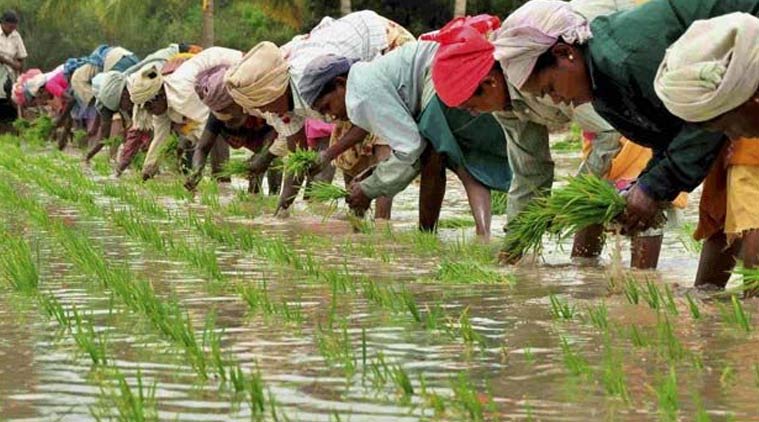- India
- International
Empower, don’t patronise, the farmer
Challenge is to come up with a method of determining compensation that makes farmers beneficiaries, not victims or obstructionists.
 If people have to surrender their land to the government at old agricultural prices while neighbours or outsiders made a windfall selling to private parties at new industrial prices, they will protest.
If people have to surrender their land to the government at old agricultural prices while neighbours or outsiders made a windfall selling to private parties at new industrial prices, they will protest.By: Maitreesh Ghatak and Parikshit Ghosh
The government’s attempt to amend the UPA’s land acquisition law is facing stiff resistance in Parliament and outside. The Land Acquisition, Rehabilitation and Resettlement (LARR) Act, 2013, combined three different approaches to resolve conflict over land. One is to let money speak. It increased compensation amounts significantly. The second is to let farmers speak. Projects involving private companies had to earn the consent of 80 per cent of affected households. The third approach is to let bureaucrats speak. Compulsory acquisition must be vetted by experts doing social impact assessment.
The result fits quite well the definition of a donkey, which is a horse designed by committee. In trying to please bureaucrats, civil society activists and farmers at the same time, the 2013 law made land acquisition not only expensive but also cumbersome and slow.
The proposed amendments drop consent and social impact assessment for certain projects like defence and infrastructure.
[related-post]
The outrage over the withdrawal of the consent requirement rings hollow. According to the LARR Act, consent is needed only if a private company is involved in the project. If an airport is to be built by the Airports Authority of India, the opinion of farmers who lose land does not count. If the project is awarded to a private company like GMR to get around public sector inefficiency and funding crunch, grassroots democracy suddenly becomes sacrosanct.

This reflexive statism is ironic if we look at history. Less than 10 per cent of forcible land acquisition in post-Independence India was for industry. Most of it was for public sector projects like dams, roads, railways and administrative buildings. Where were the protesters when the government exempted itself from consent or higher compensation in the 2013 act, which is like the wolf protecting the henhouse from everyone but itself?
It is also time we reflected on what “public purpose” really stands for. Does an airport or expressway serve the common man who travels on the roof of trains? Will a private textile mill not generate low-skilled jobs and supply cheap, mass-produced consumption goods to low-income households? What logic dictates that the government can grab land to fly the rich but not clothe the poor?
The fundamental problem that eminent domain was designed to address is that it is difficult to purchase huge amounts of contiguous land from the market. Any large project, whether in the public or private sector, faces the risk of getting stuck, or worse, not even started due to this problem. This is why a gentle helping hand from the state is needed. The challenge is to come up with a method of determining compensation that makes farmers the beneficiaries of land conversion rather than victims or obstructionists. That is the crux of the matter, not irrelevant squabbles over the definition of public purpose or need for expert committees. Unfortunately, the 2013 act got it wrong where it matters.
Even setting aside the fact that the price of land transactions is often underreported and poorly recorded, compensation according to past market price (as specified in the now defunct 1894 law) was unfair. If a factory or SEZ is to be set up in a poor agricultural region, it immediately becomes a game-changer and can cause a real-estate boom almost overnight. If people have to surrender their land to the government at old agricultural prices while neighbours or outsiders made a windfall selling to private parties at new industrial prices, they will protest.
Compensation should be linked to the emerging market price rather than what exists on the records. Without having a clue how to measure this, the previous government decreed that recorded prices should be multiplied by four to determine compensation. There is simply no logic behind this.
There are ways to assess a more contemporary and relevant price without relying on the guesswork
of lawmakers and bureaucrats. Once news about the upcoming project
is made public, the government should buy some land in and around the project site through an auction. All landowners in the region can be required to submit asking prices for their plots and the cheapest offers accepted. Some of the project land will be acquired in the auction itself. Remaining landowners can be given plots purchased around the project site instead of paying them in cash.
What robs land acquisition of legitimacy is the fact that the price is dictated by the state. Unless farmers can participate in the determination of price, the problem will not go away. If you ask farmers for how much money they are willing to give up their land, they may ask for the moon. The key to a workable solution is to combine participation with competition.
Competition can be generated by a provision to move some people to off-site land and also by a willingness to move the project. For example, if the government outlined two or three different corridors as potential sites for the Yamuna Expressway and announced that it would use the one where farmers were willing to give land at the lowest price, it could attract honest bids and minimise coercion.
Many of our current troubles spring from the inability to put a price on valuable natural resources like land, minerals, natural gas and airwaves. The lesson to be drawn from the UPA’s scandals is that relying on the discretion of politicians, bureaucrats and expert committees leads to ignorant guesswork at best and corruption at worst. The best way to put a price on a scarce resource is through transparent and competitive bidding among its many claimants.
Unfortunately we refuse to extend this lesson to land. We demand SIAs, forgetting the track record of experts and officials wielding discretionary powers. We insist on farmers having the right to vote on arbitrary prices determined in Lutyens Delhi but not the right to bid on their own land reflecting local conditions and opportunities. The LARR Act patronised farmers. It did not empower them.
The byzantine process of land acquisition the UPA created needs to be simplified but unless its successor can find a way of determining compensation from the ground up rather than top down, development will be held hostage by the same old conflicts.
Ghatak is professor of economics at the London School of Economics, UK. Ghosh is associate professor at the Delhi School of Economics.
EXPRESS OPINION
More Explained
Apr 27: Latest News
- 01
- 02
- 03
- 04
- 05











































